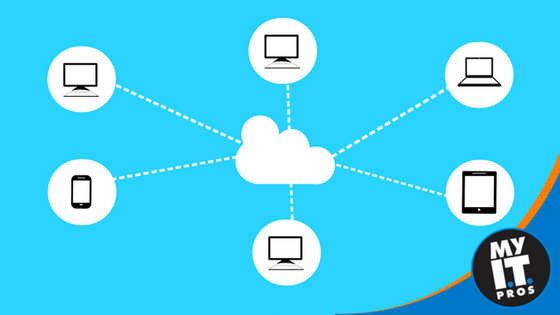
You may recall an old sketch on “Saturday Night Live” during the heady days of the dot-com bubble that featured Jimmy Fallon as “Nick Burns, Your Company’s Computer Guy.” Fallon, who played a long-suffering, nerdy IT guy, harangued his co-workers whenever they asked for his help. The more they pressed him for assistance, the more viciously he rolled his eyes, all while spouting perfectly unintelligible computer jargon.
Of course, that was over 20 years ago. Today’s greatest technological minds are as likely to pop up at Burning Man as they are at Comic-Con, and now every job is a technical role—meaning everyone in the company needs to be able to identify software and applications to help them work more efficiently and face off against competitors.
Comedic exaggeration aside, Fallon’s ‘90s-era character still typifies how some modern companies view the IT department: technologically snobbish, unhelpful and unyielding. This is exactly the kind of attitude that has led thought leaders in the tech space to characterize IT teams as “the department of no.”
CIOs and CTOs understandably tend to bristle at this portrayal of IT team culture, and it’s certainly true that most business technology leaders mean well—and many are innovative, thoughtful and helpful. That said, the introduction of cloud computing to everyday business has made the limitations of the CIO/CTO mindset (or at least the attitude of certain CIOs and CTOs) glaringly apparent. Indeed, numerous tech leaders have ended up arguing against productive, efficient technologies, for reasons we’ll discuss below.
But as we’ve seen time and time again, technology always finds a way to get around any obstacle—even if that obstacle happens to be the company IT team. CIOs and CTOs who fought hard against cloud migration frequently found themselves stripped of their budget and decision-making power, jockeying against other department leaders for technological control. Some thought leaders even asked if CIOs and CTOs were necessary at all, given the distributed technological management model of the cloud.
Admittedly, the concept of doing away with CIOs and CTOs altogether seems a little extreme; even if IT tasks are delegated to various vendors and managed through SaaS tools, businesses still need someone to make high-level technical decisions. As it currently stands, most of today’s organizations wouldn’t want just any member of the team choosing their server type or database software, whether cloud-based or otherwise.
Even so, the job of the CIO or CTO has been permanently altered by cloud adoption. Therefore, it’s certainly worth investigating how the cloud—and particularly its effects on CIOs and CTOs—has shifted the nature of the role, as well as how it stands to shape the position over the next decade.
CIO and CTO roles before and after the cloud
Before the cloud, the CIO and CTO were the Great Oz of the business technology sector: They chose the hardware, software and networking solutions for every employee in their organization, and anyone who wanted to move to a new computer or install a new CRM would have to plead their case first.
However, with the proliferation of cloud technologies—more specifically, the influx of cloud-based SaaS tools that came as a result of cloud computing—employees no longer needed CIO or CTO approval before installing new tools. Indeed, today’s team members can subscribe to a new service or online tool in a matter of seconds, without requiring the assistance of internal IT team members.
Of course, from the IT perspective, that convenience isn’t always what it’s cracked up to be, particularly when it comes to end-user security. Offering this kind of freedom of choice may help teams respond to new challenges quickly, but it also means CIOs—who are generally more informed about cybersecurity risks than your average team member—can’t ensure that users select secure products from trusted developers or follow best practices for cloud data storage. That’s a big problem, especially since studies regularly reveal the cavalier attitude of cloud users toward their data. For instance, recent analysis from Skyhigh Networks, a McAfee company, found that 18% of documents stored in the cloud contain some type of sensitive data.
As you might imagine, enforcing compliance and maintaining operational controls is incredibly difficult in such an environment. To add another layer of complexity, IT workloads and maintenance may be split across several vendors, meaning it may be harder to verify the security controls and data protections needed to meet industry compliance requirements.
That adds up to a truly demanding role in which tech leaders must stay aware of an increasingly populated ecosystem of applications, security tools and networking systems or face irrelevance. CIOs and CTOs must have their fingers in every pie, working collaboratively across teams to present a harmonized strategic vision for business innovation. Moreover, they must play the role of referee, ensuring that team members have the education and training they need to use cloud systems wisely. In the context of such a tall order, it’s easy to see why certain tech leaders might think fondly of the old days of on-premise computing.
Are CTOs and CIOs still resisting cloud migration?
At this point, the cloud is no longer a beta technology—after all, AWS just celebrated its 12th anniversary this spring—yet there are still plenty of companies that continue to resist cloud migration in favor of older, on-premise resources. Close to 40% of business workloads are still being run on-prem, according to a recent survey from SaaS network monitoring service LogicMonitor. While certain tasks are not appropriate for the cloud—particularly the public cloud—a 2017 study from Tech Pro Research, a research venture managed jointly by TechRepublic and ZDNet, found that 37% of surveyed businesses said they were still evaluating hybrid models to help mitigate public cloud-associated risks.
Understandably, it’s difficult to migrate when you’ve already invested so much time and energy into on-site solutions, and the complexity of cloud solutions only adds to the problem. There are considerably more players in the cloud space than there were five years ago, and the sheer array of options alone is enough to cause some hesitation. After all, what we call “the cloud” isn’t really a single platform or configuration, and cloud server providers have massive catalogs designed to accommodate every cloud instance that businesses can dream up. Before implementing a service, CTOs or CIOs must sort through a variety of different configuration options: server CPU, memory, instance storage, boot partition size and more.
Essentially, what often appears to CEOs as a simple choice is actually a tangled labyrinth of technical decisions. Choosing the right fit for each workload isn’t as black-and-white as it might seem at first glance, and opting for the wrong capacity can severely hamper the savings associated with the cloud—which doesn’t exactly reflect well on the CIO or CTO who chose it.
Then there’s the issue of security in the cloud. Technology officers, who are likely more in tune with cybersecurity risks than other executives, know all too well that the fast deployment times and convenience offered by the cloud require some tradeoffs in business security. We’ve already touched upon how users subvert business security by improperly uploading sensitive data to the cloud, and even more havoc can be unknowingly wreaked on cloud networks by uneducated employees. Weak passwords, data loss and successful phishing attacks often originate with end users, and cloud networks are rife with hacking; reportedly, Microsoft’s cloud fields over 1.5 million attempted intrusions a day.
CTOs and CIOs are justifiably concerned about security in the cloud—especially considering the fact that, for many, a very public data breach or hack could cost them their jobs. You may remember the period after the Equifax hack when both the company’s CIO and CSO announced their “early retirements.” Needless to say, when nearly 40% of organizations say a public breach is grounds for immediate dismissal, the stakes are high for tech leaders.
Even if a CTO or CIO goes with a reputable, well-known cloud service, an error in configuration could come back to haunt them. Recently, World Wrestling Entertainment and Verizon announced that they had both accidentally exposed customer data. The culprit? Improperly configured Amazon S3 cloud repositories. In fact, data breaches can often be attributed to misconfigured cloud instances—and most of those errors are introduced by end users and cloud administrators, not by cloud providers. Research from Gartner indicates that by 2020, 95% of cloud security failures will be the customer’s fault; in other words, an organization’s business security rests in the hands of the CIO or CTO and that individual’s ability to correctly configure (or wisely delegate) for optimal security. With this in mind, it’s easy to see why cloud migration might make CIOs and CTOs a little queasy.
Although the CIO/CTO aversion to the cloud is well documented, there are signs this attitude is shifting. The growing rate of cloud adoption alone points to a general acceptance of the technology—begrudging or otherwise—and David S. Linthicum, chief cloud strategy officer at Deloitte Consulting, declared last year that “CIOs have stopped fighting the cloud.” Indeed, AWS has developed a team of ex-CIOs tasked with “selling” the digitalization to enterprise businesses, and a Gartner survey of 461 government CIOs revealed that respondents saw cloud computing as the No. 1 technology needed to accomplish their organizational goals.
Ultimately, it seems the next generation of technology leaders has accepted the cloud as an efficient, cost-effective tool. Next, CIOs and CTOs need to embrace the newest iterations of their roles and learn how to survive in the cloud.
Shifting budgets require CIO and CTO masters of diplomacy
According to some estimates, as much as 50% of business IT budgets is controlled outside the IT department. Nowadays, the number of teams that depend on technology to do their jobs means it no longer makes sense to give CTOs or CIOs the final say on every technology decision. In fact, a lot of what’s left in the budget goes to “keeping the lights on”—according to “Fortune,” CIOs frequently spend around 80% of their budget on routine operational expenses. And naturally, as CIOs’ budgets dwindle, so does their power to effect organizational change, at least where finances are concerned.
Meanwhile, the very sense of what a CTO or CIO should be is in flux. A recent report from Oracle highlighted this role confusion by stating that today, the abbreviation “CIO” more rightly stands for “Chief Innovation Officer.” Simply put, there is a great deal of pressure on businesses to disrupt their industry with new solutions that will allow them to stay competitive in the market. In most cases, those business innovations occur jointly with new technology—an assertion supported by the findings of a survey by Insight Enterprises, a global B2B IT provider, which revealed 65% of business owners felt that IT disruption would impact their tech spending decisions.
In today’s world, technology is a means to deliver conventional products and services in a more efficient, productive fashion. From this perspective, CTOs and CIOs who want to continue adding value to their organizations must work to form strategic partnerships with CEOs and internal team members to build innovative solutions and products. They must then use these interactions to evaluate how employees can leverage emerging technologies and existing tools to work more effectively and productively, thereby freeing up time for new business opportunities.
Essentially, tech leaders must flex their diplomatic muscles, working closely with those most familiar with the organization’s business needs and then using existing technologies to deliver products and services in new ways. Technology leaders should adopt a consumerizational approach to business innovation—a tack that, it should be noted, is enabled largely by the popularization of cloud technologies. And they must do it all with smaller budgets for maintenance and new development.
The cloud as a jumping-off point to other technologies
Given the new rigors of the job, the CIO role understandably looks a little less glamorous than it did 15 years ago. There’s a new paradigm emerging in which every leader must be a tech leader, and CIOs and CTOs—who must now juggle the dual functions of maintenance and innovation—may find their power on the latter front diminished by the influence of other executive team members.
That said, if the emergence of the cloud has made the CIO/CTO role more difficult, it’s also opened up new digital business opportunities, adding energy and excitement to the innovation side of the CIO/CTO split personality. That attitude should serve CIOs and CTOs well in the coming years, especially given that there’s another technology revolution in the works. A trio of cutting-edge technologies—AI, machine learning and big data—is poised to send waves through our work lives throughout the next decade, upending an array of conventional roles and daily tasks.
The good news is that many CIOs and CTOs already accept the inevitability of these new technologies, and this has had a positive effect on their ability to influence adoption. A CIO.com survey of 500 CIOs found that 72% say they’re leading organizational digitization efforts, while 90% say they are either planning on using or have already implemented machine learning tools in their business. Similarly, when LogicMonitor surveyed IT professionals on the future of the cloud, 66% of respondents said AI and machine learning were poised to become a major driver of cloud workload adoption. By 2021, Gartner predicts that organizations will spend more on chatbot and bot development than on building conventional mobile applications.
Interestingly, investing in these technologies—particularly analytical tools and machine learning applications—should help to ease the current CIO/CTO workload. For instance, smart executives can use data analysis to identify new business opportunities and areas for expansion. Moreover innovative CIOs and CTOs will leverage machine learning capabilities to boost productivity and profitability, freeing up resources and human capital for new initiatives. CIOs and CTOs who once resisted the sea change brought on by the cloud are rushing to embrace new technologies that will make their job easier.
CIOs and CTOs need backup
In the end, it’s unlikely that businesses will ever completely do away with IT management roles. It may be more convenient to distribute certain technical decisions among various teams, but most team members don’t have the technological chops to manage complex controls and equipment. Meanwhile, someone needs to uphold standards of consistency throughout the organization.
That doesn’t mean IT management won’t continue to evolve, however. As TechRepublic points out, one of the greatest issues with the new CIO role is its split focus: tasking CIOs and CTOs with both routine maintenance and digital innovation is burdensome and impractical, and the two sides are intrinsically at odds with one another in myriad ways. At the very least, they require two very different sets of skills to meet business objectives.
That gives forward-thinking organizations two options: either divide the role in half and task one executive with “keeping the lights on” or hire for innovation and lean more heavily on IT providers for help. There is a movement among MSPs to think of themselves as strategic partners rather than mere service providers, and giving trusted vendors more leeway to manage routine maintenance tasks themselves—monitoring, regulatory compliance, network security, etc.—eases the pressure on CIOs and CTOs, allowing them to focus on business opportunities and innovation.
Moving critical maintenance to outside vendors does take a leap of faith, but indicators point to this being necessary in many instances. According to insights from IDG Research, 72% of CIOs have problems juggling operational concerns with innovation, so it’s worth revisiting how teams can effectively leverage their existing resources to refocus their energy on innovation and growth.
Regardless of what the future holds for CIOs and CTOs, cloud adoption and its impact come with at least one silver lining: Although 87% of CIOs admit their jobs are more challenging today than ever before, the added difficulty hasn’t seemed to faze them. In contrast, 62% of respondents to the same survey said they like the new demands of the job, indicating that they find their work more rewarding than in the past. For modern CIOs and CTOs, there is a real chance to permanently alter their organization’s business future and set the technological tone for tomorrow—provided they learn to let go of the past and embrace new technologies’ potential before their competitors.



